
Do you have swelling in your legs?
Are your legs discolored?
Do you have varicose veins?
Do you have numbness, pain or tingling in the legs?
Do you have throbbing in the legs or itchy, scaly skin?
Do you have, or have you had, wounds in the lower leg/calf area?
You could have chronic venous insufficiency (CVI). Understanding venous disease means understanding the function and anatomy of the venous system. Veins carry blood with CO2 and metabolic waste products back to the heart and lungs to be replenished with oxygen and nutrients. To reach the heart, blood needs to flow upward in the veins from the legs- against gravity. The contraction of the muscles in the legs help to propel the blood upward. To keep the blood flowing up and prevent backflow, the veins contain one-way valves. CVI occurs when these valves become damaged allowing blood to flow backwards and pool in the leg veins. Over time, this malfunction of the valves causes pressure to build up in the veins. Fluid then leaks out into the tissues causing swelling and inflammation Chronic inflammation results in progressive problems, such as pain, bulging veins, skin changes or the most serious complication, blood clots. Blood clots that form in the deep veins of the legs (DVT) can travel to the lungs and cause serious complications, even death.
The symptoms of venous disease can vary greatly. They are often so insidious that, after treatment, patients are surprised to realize how much chronic discomfort they had accepted as “normal”. Common symptoms include burning, swelling, throbbing, cramping, and leg fatigue. The appearance of the lower extremities is often very helpful in the diagnosis of venous disease. Some people will notice swelling, changes in the color and texture of the skin, dry scaling, itchy skin, visible spider veins or bulging veins in the calf and thigh. Others will experience more serious soft tissue changes that develop as the disease progresses which include chronic inflammation or cellulitis, varicosities that bleed without warning, or wounds that come up like small blisters and take a long time to heal. The most serious complications from chronic venous insufficiency are blood clots (DVT’s), and non-healing wounds that become infected – sometimes spreading to bone or into the bloodstream.
Risk factors include:
*Family history
* Obesity
* Damage to your leg due to injury, surgery, or previous blood clots
* Occupations that require sitting or standing for long periods of time
* Reduced mobility or sedentary lifestyle
* More than one pregnancy
In order to diagnose CVI, a complete medical history and examination of your legs will be required. A vascular ultrasound may also be useful to assess the blood flow in the leg veins. Like any disease, CVI is most easily treated in the early stages. Conservative treatment strategies include avoidance of long periods of standing and sitting, regular exercise, weight loss, elevating your legs at night, practicing good hygiene and treating active skin infections. Properly fitting, medical grade support hose called compression stockings are a common conservative treatment option. Compression stockings come in different lengths and compression strength. To ensure a proper fit, compression stockings should be prescribed by a health care provider. Endovenous laser thermal ablation (EVLT) is a relatively new technique that uses a laser to create heat in the abnormal vein causing it to shut down, and redirecting blood flow to deep veins. This technique is minimally invasive, can be done in under an hour, involves less pain than traditional therapies, and allows for a quick return to normal activities. Sclerotherapy is another minimally invasive option; it involves injection of a solution directly into the vein that causes the vein to collapse and shut down.
If you think you may have this problem, you can discuss it with your primary health care provider, or seek out one of the many specialists who offer treatment options – including cardiologists, vascular surgeons, and interventional radiologists. You are also welcome to call our center to schedule a prompt and free consultation- you can reach us at (405) 608-8884














